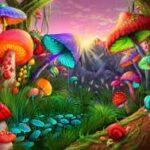How Long Does DMT Last?

DMT, chemically known as N, N, Dimethyltryptamine is a powerful hallucinogenic drug found in several plants that can be smoked, snorted or mixed with ayahuasca. DMT was first found to be psychedelic by the Hungarian chemist Stephen Szára in the 1950s. In the 60s, it was discovered in the human body, with research suggesting it is synthesized in lungs and the pineal gland in the brain. It is now believed to be widespread throughout the natural kingdom, in thousands of plants, and in every mammal that has been investigated so far.
Studies indicate that DMT works by partially blocking the discriminative stimulus effects of phencyclidine, which produces hallucinations through its actions at NMDA receptors. DMT is capable of producing experiences that, in intensity, surpass those associated with standard doses of most orally administered psychedelics and indeed most other categories of psychoactive drugs.
What does DMT look like?
- A white crystalline powder or solid, when in its pure form.
- A yellow, orange or pink powder or solid, when not pure – which is more common.
- A brownish/green herbal mixture, when mixed with herbs to make changa.
- A brownish/red liquid when part of an ayahuasca brew.
What does DMT taste/smell like?
DMT has a very strong and unusual smell and taste which people have likened to burnt plastic and new shoes.
How Long Does DMT Last?
The subjective effects of DMT have a rapid onset and are characterized by unusually vivid visual imagery and somatic effects, which arise within seconds of the injection. At high doses, the experience rapidly progresses into a deep and profound immersion – sometimes described as a ‘breakthrough’. This experience is often characterized by a sense of entering into an entirely ‘other’ but no less ‘real’ world or dimension.
DMT stimulates the production of serotonin, a neurotransmitter that causes feelings of happiness. DMT causes users to experience intense euphoria, hallucinations, and new perceptions of reality which people often characterize as life-changing. A DMT trip can begin instantly and generally lasts less than an hour when users smoke the drug. Users who drink DMT as a brew often begin to experience hallucinations that last for four to six hours after about thirty minutes. Some users report mild lingering effects that last for several days.
Side effects of DMT
In comparison to other psychedelic drugs, such as LSD, ketamine, and magic mushrooms, recreational users of DMT consider it to have the lowest side effect profile.
According to the DEA, the American Psychiatric Association (APA), and academic sources, such as the book The Neuropathology of Drug Addictions and Substance Misuse Volume 2 Possible side effects of DMT can include:
- Hallucinogenic effects, as outlined above
- Issues with anxiety that can be severe and are similar to having a panic attack
- Physical changes that may exacerbate anxiety, such as increases in heart rate, body temperature, and blood pressure
- Difficulty breathing (unclear whether this represents a complication of anxiety or a specific autonomic nervous system issue)
- Nausea, diarrhea, and vomiting; if untreated, can lead to dehydration
- Unconsciousness in some individuals
- Mental health issues: DMT use may cause problems that are normally associated with having a formal mental health disorder, such as psychosis, anxiety, mood swings, and/or depression. This risk is increased with individuals who experience unpleasant effects or “bad trips” as a result of using hallucinogenic drugs.
- Cardiac issues: Cardiac arrest can occur in people who have pre-existing cardiac problems or in individuals who are using other medications for depression or chronic pain. Individuals who are using opiate drugs may be at particular risk to develop cardiac problems when using DMT.
- Asphyxiation: Possible asphyxiation may occur in individuals who lose consciousness as a result of taking DMT and begin throwing up.
- Seizures: The DEA reports that there are some cases of reported seizures that are associated with DMT use. It is unclear if these instances occurred as a result of an individual using DMT alone or in combination with other drugs. In any event, the development of seizures represents a potentially fatal condition.
- Damage to major body systems: Hallucinogenic drugs are often combined with other drugs, and this increases the potential for damage to a number of organ systems, including the central nervous system (the brain and spinal cord).
- Addiction: A hallucinogen use disorder can develop as a result of chronic abuse of hallucinogens like DMT.
- Flashbacks: APA describes a rare disorder that can occur in some individuals who use hallucinogenic drugs: hallucinogen persisting perception disorder. This is a formal mental health disorder that consists of having drug flashbacks when one has not used a specific hallucinogenic drug for some period of time. The disorder is most often connected to past use of LSD along with a history of bad trips, some other psychological disorder, and other issues, but it can conceivably occur in anyone who chronically uses a hallucinogenic drug. Flashbacks appear to suddenly develop without any drug use. Individuals may become very frightened, and the DMT experiences can often be mistaken as psychotic episodes or some type of neurological insult, such as stroke. Treatment for the disorder consists of medications to manage specific symptoms; in some cases, anticonvulsant drugs may be useful.
It is important to note that although the effects of LSD can last up to 12 hours or more, DMT side effects may only persist for several minutes to a few hours, depending on the amount and how the drug is taken.

